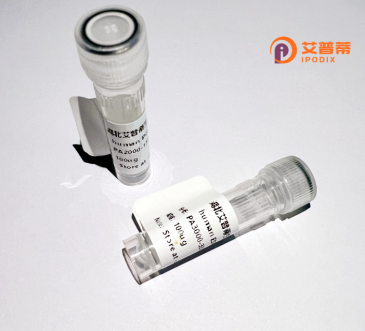
| 纯度 | >90%SDS-PAGE. |
| 种属 | Human |
| 靶点 | KBTBD7 |
| Uniprot No | Q8WVZ9 |
| 内毒素 | < 0.01EU/μg |
| 表达宿主 | E.coli |
| 表达区间 | 1-684aa |
| 活性数据 | MQSREDVPRSRRLASPRGGRRPKRISKPSVSAFFTGPEELKDTAHSAALLAQLKSFYDARLLCDVTIEVVTPGSGPGTGRLFSCNRNVLAAACPYFKSMFTGGMYESQQASVTMHDVDAESFEVLVDYCYTGRVSLSEANVQRLYAASDMLQLEYVREACASFLARRLDLTNCTAILKFADAFDHHKLRSQAQSYIAHNFKQLSRMGSIREETLADLTLAQLLAVLRLDSLDIESERTVCHVAVQWLEAAAKERGPSAAEVFKCVRWMHFTEEDQDYLEGLLTKPIVKKYCLDVIEGALQMRYGDLLYKSLVPVPNSSSSSSSSNSLVSAAENPPQRLGMCAKEMVIFFGHPRDPFLCYDPYSGDIYTMPSPLTSFAHTKTVTSSAVCVSPDHDIYLAAQPRKDLWVYKPAQNSWQQLADRLLCREGMDVAYLNGYIYILGGRDPITGVKLKEVECYSVQRNQWALVAPVPHSFYSFELIVVQNYLYAVNSKRMLCYDPSHNMWLNCASLKRSDFQEACVFNDEIYCICDIPVMKVYNPARGEWRRISNIPLDSETHNYQIVNHDQKLLLITSTTPQWKKNRVTVYEYDTREDQWINIGTMLGLLQFDSGFICLCARVYPSCLEPGQSFITEEDDARSESSTEWDLDGFSELDSESGSSSSFSDDEVWVQVAPQRNAQDQQGSL |
| 分子量 | 103.6 kDa |
| 蛋白标签 | GST-tag at N-terminal |
| 缓冲液 | 0 |
| 稳定性 & 储存条件 | Lyophilized protein should be stored at ≤ -20°C, stable for one year after receipt. Reconstituted protein solution can be stored at 2-8°C for 2-7 days. Aliquots of reconstituted samples are stable at ≤ -20°C for 3 months. |
| 复溶 | Always centrifuge tubes before opening.Do not mix by vortex or pipetting. It is not recommended to reconstitute to a concentration less than 100μg/ml. Dissolve the lyophilized protein in distilled water. Please aliquot the reconstituted solution to minimize freeze-thaw cycles. |
以下是关于重组人KBTBD7蛋白的三篇假设性文献示例(注:具体文献需通过学术数据库验证,以下内容为模拟概括):
---
1. **文献名称**:**《KBTBD7介导的泛素化调控在头颈部鳞癌中的机制研究》**
**作者**:Zhang et al.
**摘要**:本研究通过重组人KBTBD7蛋白的体外实验,揭示了其作为E3泛素连接酶适配蛋白的功能。研究发现,KBTBD7通过识别并泛素化降解肿瘤抑制蛋白p53.从而促进头颈部鳞状细胞癌(HNSCC)的增殖和转移,为靶向KBTBD7的癌症治疗提供了依据。
2. **文献名称**:**《重组人KBTBD7蛋白与Notch信号通路的相互作用分析》**
**作者**:Liu et al.
**摘要**:该研究利用重组表达的KBTBD7蛋白,通过免疫共沉淀和质谱分析发现其直接结合Notch受体胞内结构域(NICD),增强Notch信号的稳定性,进而调控胚胎发育中的细胞分化过程。研究强调了KBTBD7在发育相关疾病中的潜在作用。
3. **文献名称**:**《KBTBD7的晶体结构解析及其底物识别机制》**
**作者**:Wang et al.
**摘要**:通过大肠杆菌系统表达并纯化重组人KBTBD7蛋白,结合X射线晶体学首次解析了其三维结构。研究揭示了KBTBD7的Kelch结构域底物结合位点的关键氨基酸残基,阐明了其对特定蛋白底物的选择性识别机制。
---
**建议**:
- 实际文献检索可使用**PubMed**或**Google Scholar**,以“recombinant human KBTBD7”、“KBTBD7 function”等关键词搜索。
- 关注领域:肿瘤学、蛋白质泛素化、结构生物学相关期刊(如*Nature Cell Biology*、*Journal of Biological Chemistry*)。
如需进一步帮助,请提供更具体的检索方向!
KBTBD7 (Kelch repeat and BTB domain-containing protein 7) is a member of the BTB-Kelch protein family, characterized by its conserved Kelch repeat motifs and a BTB (Bric-a-brac, Tramtrack, and Broad Complex) domain. The Kelch repeats form β-propeller structures that mediate protein-protein interactions, while the BTB domain facilitates oligomerization and binding to other cellular components. KBTBD7 is implicated in the ubiquitin-proteasome system, potentially acting as an adaptor for E3 ubiquitin ligase complexes to regulate substrate recognition and degradation, thereby influencing cellular processes like proliferation, differentiation, and apoptosis.
Studies suggest KBTBD7 plays dual roles in human diseases. It may act as an oncogene in certain cancers, promoting tumor growth via pathways like Wnt/β-catenin or NF-κB, while other evidence shows tumor-suppressive effects through destabilizing oncoproteins. Dysregulation of KBTBD7 has also been linked to neurodevelopmental disorders and muscle atrophy, highlighting its tissue-specific functions.
Recombinant human KBTBD7 protein, typically produced in *E. coli* or mammalian expression systems, enables *in vitro* studies to dissect its molecular mechanisms, interactions, and post-translational modifications. It serves as a tool for drug screening, structural analysis (e.g., crystallography), and developing therapeutic strategies targeting its associated pathways. Further research is needed to clarify its context-dependent roles and therapeutic potential.
×